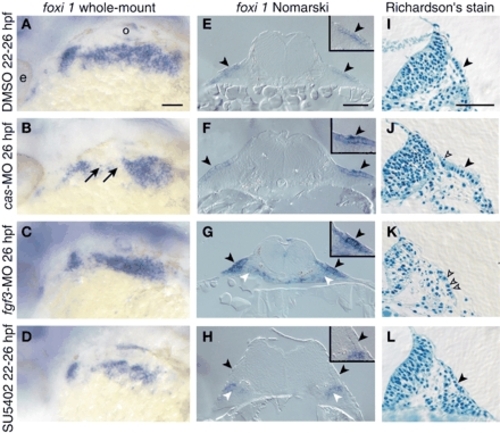
Neither endoderm nor Fgf3 is required for EB placode induction. Lateral views (A-D) and transverse sections (E-L) of embryos injected with cas (B,F,J) or fgf3 morpholino (C,G,K) or treated with SU5402 (D,H,L) or DMSO (A,E,I) beginning at 22 hpf are shown. Embryos were collected at 26 hpf and processed for in-situ hybridization with foxi1 riboprobe (A-H) or modified Richardson's stain (I-L). Panels E-G show sections through the vagal placode, while panels H-L show sections through the facial placode. EB placodes are marked by black arrowheads, while pharyngeal endoderm is marked by white arrowheads. Insets in E-H show magnified views of the placodes. Note ectodermal foxi1 expression and presence of the ectodermal thickenings in cas and fgf3 morphants, indicating presence of the EB placodes. foxi1 was not expressed in the ectoderm of the third and fourth arches (black arrows) in cas morphants. We consistently observed increased levels of the foxi1 transcript in fgf3 morphants (C,G). In addition, we observed nuclear fragmentation in EB placodes in cas and fgf3 morphants (empty arrowheads in J,K), indicating dying cells. While endodermal foxi1 expression was not affected, ectodermal expression was lost in the SU5402-treated embryos (D,H). Scale bars: 50 µm. e, eye; o, otic vesicle.
|

